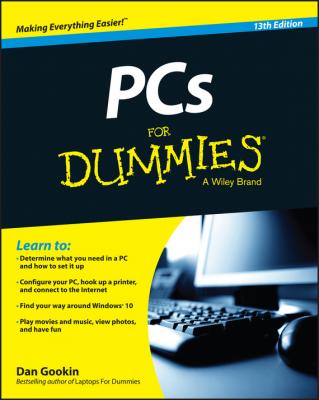PCs For Dummies. Gookin Dan
Читать онлайн.| Название | PCs For Dummies |
|---|---|
| Автор произведения | Gookin Dan |
| Жанр | Зарубежная образовательная литература |
| Серия | |
| Издательство | Зарубежная образовательная литература |
| Год выпуска | 0 |
| isbn | 9781119041788 |
Type me
You type the text Type me as shown. You’re told when and whether to press the Enter key. You’re also told whether to type a period; periods end sentences written in English, but not always when you type text on a computer.
Windows menu commands are shown like this:
Choose File ⇒ Exit.
This line directs you to choose the File menu and then choose the Exit command.
Key combinations you may have to press are shown like this:
Ctrl+S
This line says to press and hold down the Ctrl (Control) key, type an S, and then release the Ctrl key. It works the same as pressing Shift+S on the keyboard to produce an uppercase S. Same deal, different shift key.
Foolish Assumptions
You have a PC, which is an acronym for Personal Computer and describes all computers that run the Windows operating system. You do not have a Macintosh. And you are not a superintelligent gerbil desiring to program an Arduino in FORTRAN.
This book was updated to coincide with the release of Windows 10, a deadline I missed by two months. The book primarily covers Windows 10, although I pay homage to Windows 7, which is the most popular version of Windows as this book goes to press. I do not cover the horrid atrocity that was Windows 8, nor will you find material here on Windows XP or other primitive operating systems.
When this book refers to Windows without a specific edition or version, the information applies generically to both Windows 10 and Windows 7.
Icons Used in This Book
Where to Go from Here
This book features an online support page, which you can find here:
This book’s online cheat sheet, which was once included with the book before the publisher got all cheap, can be located at this web page:
www.dummies.com/cheatsheet/pcs
And bonus material is located on this page:
My email address is listed here, in case you want to send me a note: [email protected].
Yes, that’s my email address, and I respond to every email message. Expect a fast answer when you write a short, to-the-point message directly related to this book. Longer messages take me longer to read – sometimes weeks – but I will get back to you. Also, please understand that I cannot troubleshoot or fix your PC.
You can also visit my website, which is chock-full of helpful support pages, bonus information, games, and fun. Go to www.wambooli.com.
With this book in hand, you’re now ready to go out and conquer your PC. Start by looking through the table of contents or the index. Find a topic and turn to the page indicated, and you’re ready to go. Also, feel free to write in this book, fill in the blanks, dog-ear the pages, and do anything else that would make a librarian blanch. Enjoy.
Part I
Hello, PC!
In this part …
✔ Discover what a PC is and what it can do
✔ Explore the various parts of a computer
✔ Set up and configure a PC
✔ Cope with turning a computer on or off
Chapter 1
What Is This Thing, This PC?
In This Chapter
▶ Answering some common PC questions
▶ Understanding basic computer concepts
▶ Knowing about hardware and software
▶ Buying a computer
▶ Realizing that your PC is quite dumb
Iwish that computers were evil. It would be easier to understand the computer if it were upfront about being evil and expressed its malevolent desire to get you. Minus that negative assurance, you end up operating the PC under a constant suspicion. That’s not healthy. So instead of fearing, try understanding. Maybe Mr. PC isn’t so bad after all?
Some Quick Questions to Get Out of the Way
Doubtless, your mind is abuzz with various questions about computers. I ask myself computer questions often, so don’t think that your curiosity is unusual. Trust me: Few people over the age of 26 are comfortable when first encountering anything high-tech.
A PC is a computer – specifically, an acronym for personal computer.
Historically, the beast was known as a microcomputer. That’s because back in the 1970s, computers were huge, room-sized things that required legions of bespectacled scientists to operate. Individuals didn’t own such computers – well, unless you were eccentric or enjoyed printing your own phone bill. So mere mortals were sold a smaller version, which the Computer Professionals Union insisted be called a microcomputer.
Micro means teensy. The term is preferred by computer scientists because you can’t wear a white lab coat and be taken seriously when you use the word “teensy.”
Actually, the term micro comes from microprocessor, the main computer chip inside the early personal computers.
When IBM unveiled its first business microcomputer back in 1982, they called it the IBM Personal Computer – or PC, for short. All of today’s personal computers are descended from that original model, so they’ve inherited the term PC. Figure 1-1 displays a timeline of the PC’s history, in case you’re curious.
Figure 1-1: Timeline of the personal computer.
The only PC that’s not called “PC” is Apple’s Macintosh computer. Mac users refer to their computers as Macs. That’s based on an old IBM–Apple rivalry that no one cares about any more. Still, many Mac users get all huffy when you call their computers PCs. So it’s fine by me to tease those crybabies by referring to their expensive toys as PCs.
✔
